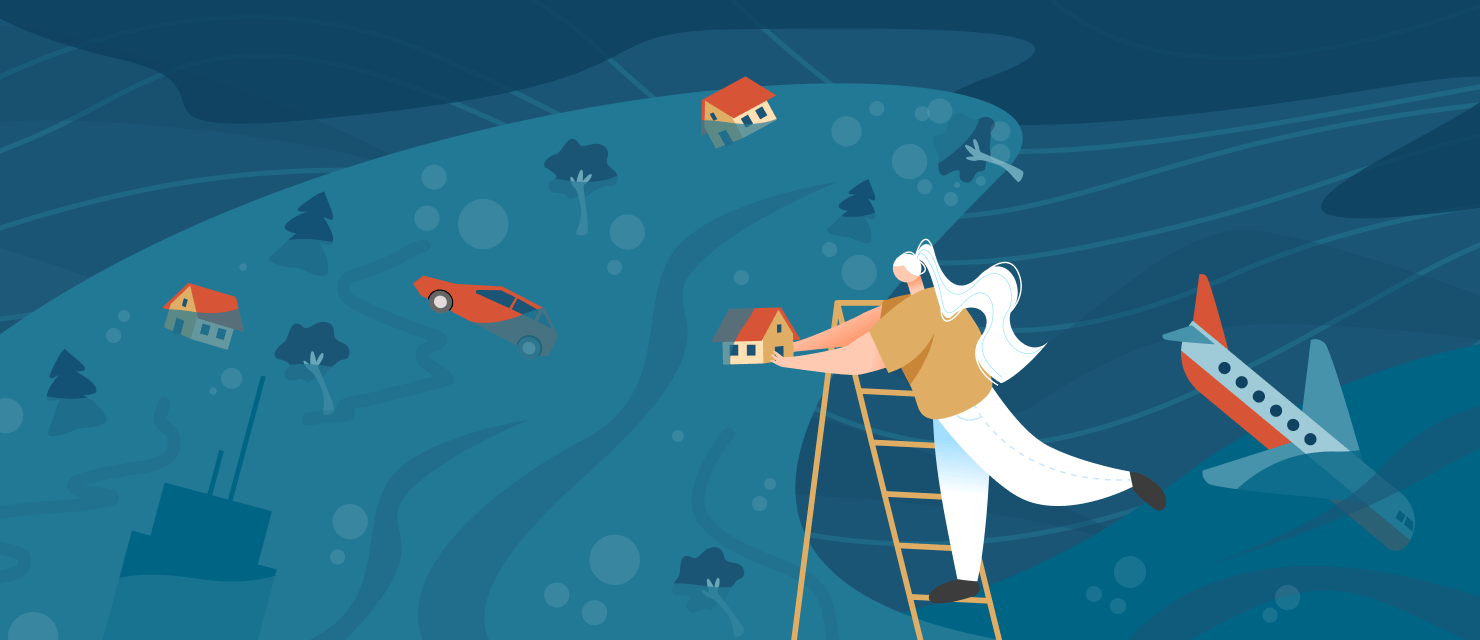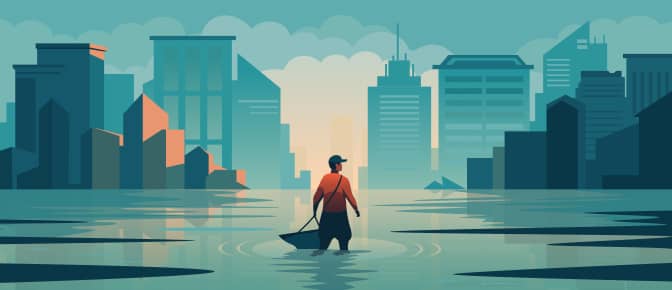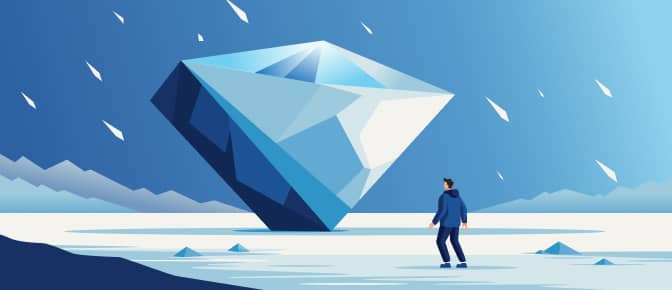The fascinating weather phenomenon, known as a tsunami, has captivated humanity for centuries with its raw power and devastating consequences. In Japanese, “tsunami” means harbor wave, but it is actually not an ordinary ocean wave. So what exactly causes these immense waves to form, and how do they transform from a mere ripple into a fearsome tidal surge?
Tsunamis are a series of long, tall, and massive oceanic waves caused mainly by earthquakes below or near the ocean floor. In extreme cases, the height of a tsunami can exceed 100 feet (30 meters). Here is a list of the world’s deadliest tsunamis (as of 2023):
| Deaths | Year | Location | Cause |
|---|---|---|---|
| 227,899 | 2004 | Indonesia | Earthquake 9.1M |
| 50,000 | 1755 | Portugal | Earthquake 8.5M |
| 34,417 | 1883 | Indonesia | Volcano eruption |
| 31,000 | 1498 | Japan | Earthquake 8.3M |
| 27,122 | 1896 | Japan | Earthquake 8.3M |
Source: NOAA
Tsunami Characteristics
The key characteristics of a tsunami are as follows:
- Long wavelength. Tsunamis are characterized by long wavelengths, which refer to the distance between successive wave crests. Unlike regular ocean waves that may have wavelengths of only a few feet, tsunami wavelengths can stretch for tens or even hundreds of miles. This is because of the great amount of energy that they carry.
- High speed. The exact speed of a tsunami can vary depending on various factors. For example, it can be the depth of the ocean and the initial energy released. Tsunamis can reach speeds of tens to hundreds of miles per hour.
- Great destructive potential. Destructive tsunamis carry a tremendous amount of water, often resulting in a surge reaching far inland upon landfall.
How Tsunamis Form
There are four main stages of tsunami formation: initiation, split, amplification, and run-up.
 Source: Pacific Coastal and Marine Science Center
Source: Pacific Coastal and Marine Science Center
Initiation
When two parts of the earth’s crust move against each other, they can lead to earthquakes under the sea. These earthquakes are the most causes of tsunamis that happen in the world. The Global Historical Tsunami Database says that over 80% of the tsunamis that happened since 1900 came from earthquakes. But other things can cause tsunamis too, like landslides, volcanic eruptions, specific types of weather, and meteorites hitting or blowing up over the water.
For example, here’s a photo of a huge crack in the seafloor near Japan resulting from an earthquake:
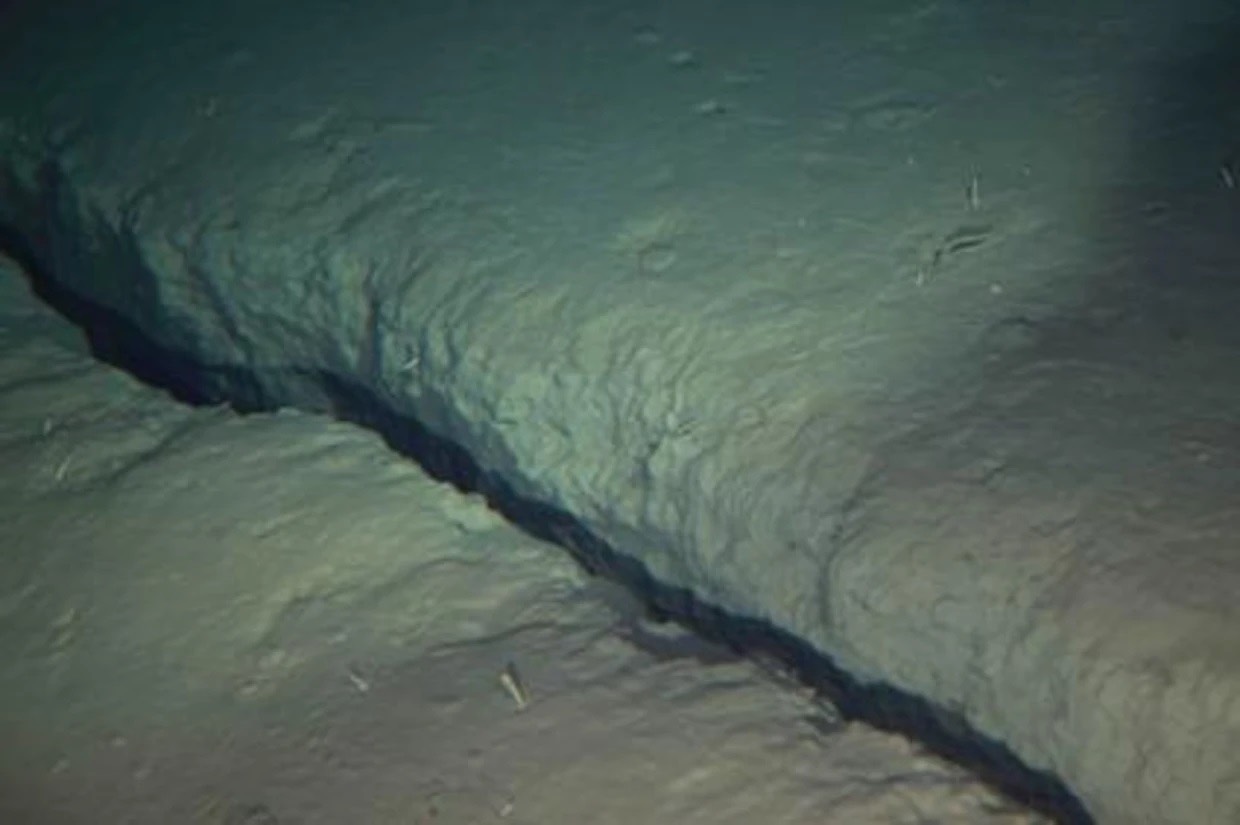 Source: NBC News, Norio Miyamoto, JAMSTEC
Source: NBC News, Norio Miyamoto, JAMSTEC
Split
After the initiation, the water starts to move far and wide because of what happened under the sea, making long waves. During this stage, a tsunami wave is divided into two components as it encounters different characteristics of the ocean.
The first component is known as the leading wave or ocean wave. It moves faster and can travel at speeds of hundreds of kilometers per hour. The leading wave continues to move across the ocean, gradually becoming lower as it disperses energy over a larger area. This tsunami component typically passes through deeper ocean regions and is not dangerous to coastal areas.
The second component is the trailing wave or coastal wave. As it approaches shallower waters near the coastline, it grows and slows down. This causes the wave to “pile up”. As a result, it can transform into a much larger and more destructive wave near the shore.
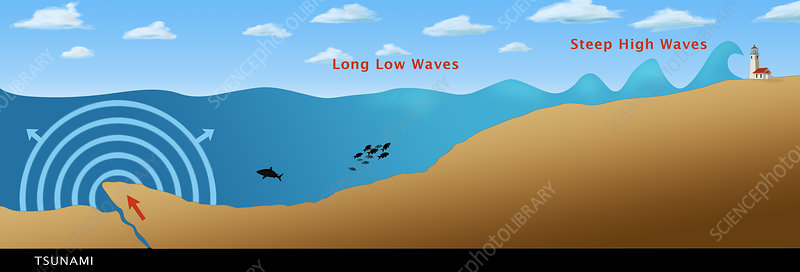 Source: Monica Schroeder / Science Photo Library
Source: Monica Schroeder / Science Photo Library
Amplification
This stage occurs as the wave approaches the coastline and meets shallower waters. At this time, tsunami waves undergo significant changes in their characteristics, including wave height and energy concentration.
As the tsunami wave moves from deeper oceanic areas to shallow coastal regions, shallower waters cause the wave to slow down further. This compresses the wave energy and results in growing wave height. The waves amplify in places where the bottom of the sea is not flat or where the shore makes the waves come together.
When the tsunami wave approaches the coastline, it may encounter various coastal features such as bays, estuaries, inlets, or narrow channels. These geographic configurations can act as natural amplifiers, concentrating the wave energy and making it grow dramatically. The wave may also undergo shoaling, where the bottom of the wave interacts with the seabed, causing the wave to rise even higher.
A famous drawback effect may occur before a tsunami hits the shore. The water retreats significantly, revealing areas of the shore that are normally submerged. Drawbacks may signal that a tsunami is nearing the shore. However, it can take only a few minutes or even seconds between the water pulling back and the full tsunami coming. Therefore, those who remain on the shore watching the exposed seabed are in danger, like what happened to tourists in Phuket, Thailand in 2004.
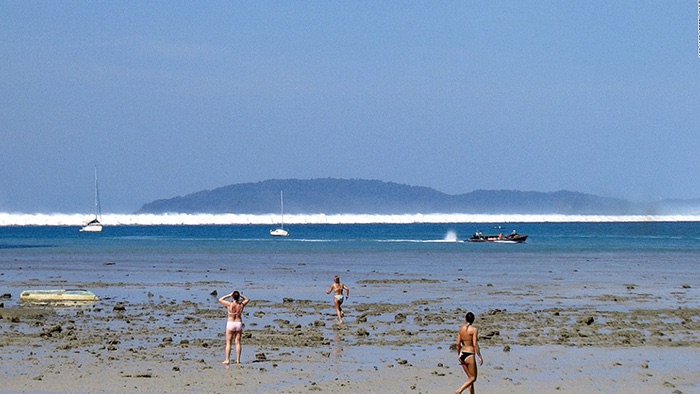 Source: National Weather Service
Source: National Weather Service
The amplification process is responsible for the destructive force associated with tsunamis, as it concentrates the energy of the wave into a smaller area. The extent of amplification depends on several factors, such as:
- the shape of the coastline,
- the slope of the seabed,
- the width and depth of coastal features,
- the distance from the tsunami source.
In some cases, the wave can grow several times higher compared to its original height in the open ocean.
Run-up
At the final stage of tsunami formation, the amplified tsunami wave reaches the coastline and interacts with the land. As a result, the water rushes inland and causes widespread flooding and devastation.
As the tsunami wave approaches the shoreline, the increasing wave height and energy concentration boost the force with which the water moves. The wave crashes when it reaches the shore, causing the wave crest to topple forward and form a turbulent mass of water. This breaking wave is often referred to as the tsunami bore or the tsunami wall.
The tsunami bore rapidly moves towards the land, often with great speed and force. When it reaches the coast, it can climb up and over natural barriers, such as cliffs or dunes, and surge inland, flooding low-lying areas.
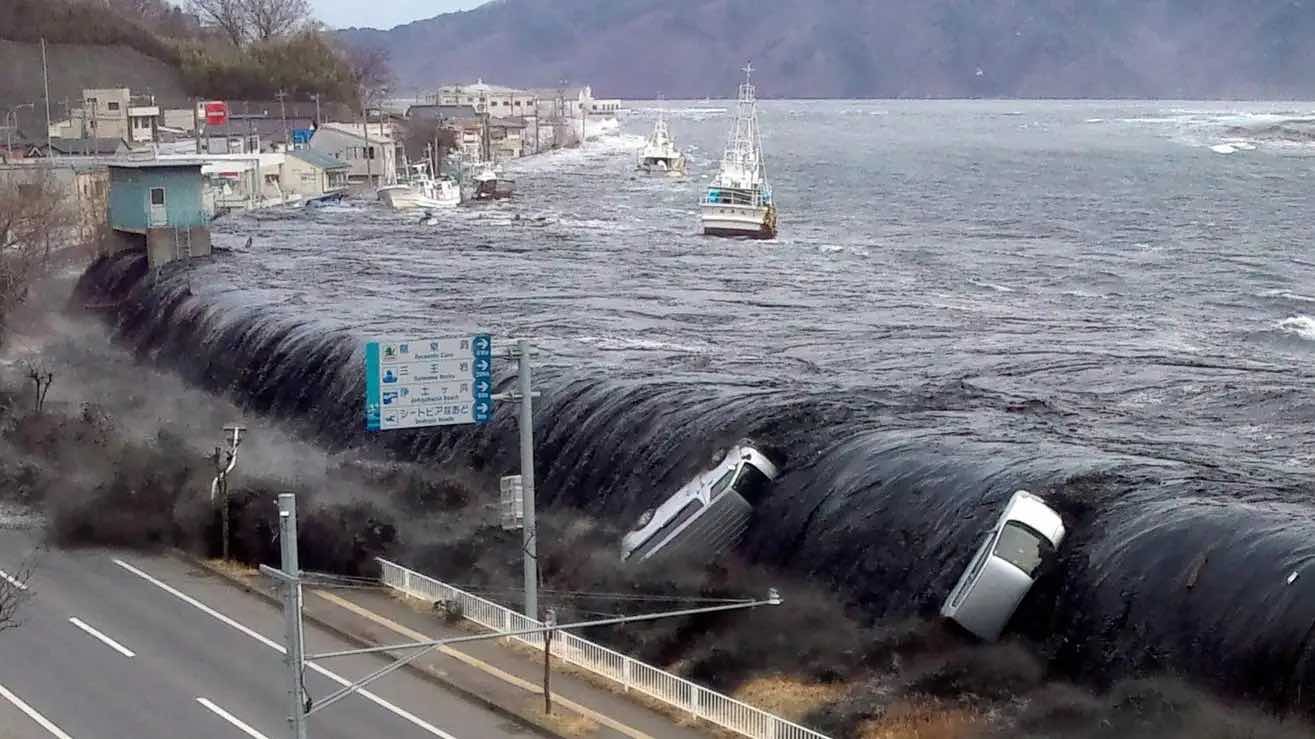 Source: JIJI PRESS/AFP (Getty Images)
Source: JIJI PRESS/AFP (Getty Images)
How Tsunamis Affect Coastal Communities
Tsunami effects on coastlines can cause widespread destruction, loss of life, and long-lasting impacts. The destructive nature of tsunamis arises from several factors:
- Flooding. As the tsunami waves reach the coast, they can inundate coastal areas, often reaching far inland. The large volume of water carried by tsunamis can submerge buildings, infrastructure, and entire communities.
- Structural damage. The force and energy carried by tsunami waves can damage and destroy buildings, bridges, and other infrastructure.
- Erosion and landscaping. Tsunamis can significantly alter the coastal landscape and topography. The force of the waves can erode shorelines, removing sediment and vegetation, and reshaping the coastline. Coastal erosion can lead to the loss of beaches, dunes, and protective barriers, leaving communities more vulnerable to future coastal hazards.
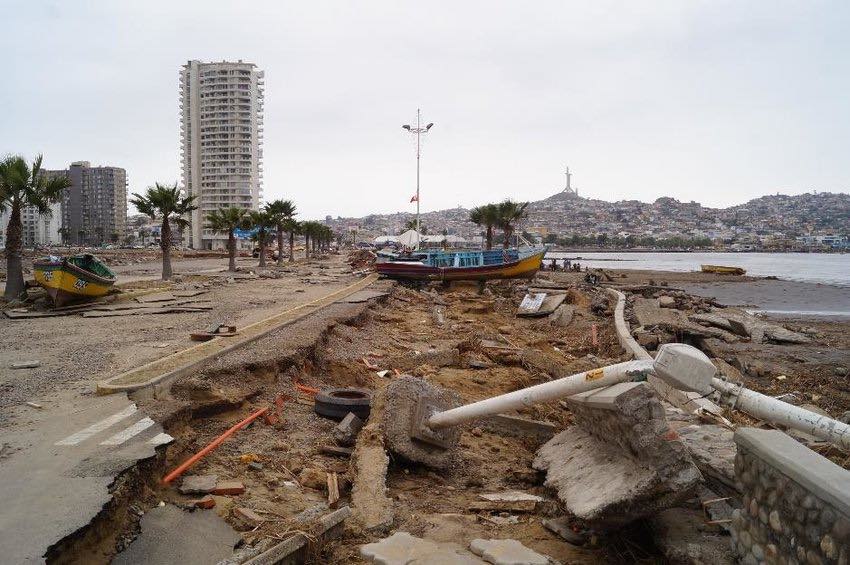 Source: ResearchGate, Prof. Gabriel Candia
Source: ResearchGate, Prof. Gabriel Candia
- Loss of life and injuries. The suddenness and speed at which tsunamis strike leave little time for people to react and evacuate. The force of the waves can cause drowning, injuries from debris, and entrapment.
- Environmental damage. Tsunamis can cause severe damage to coastal ecosystems and habitats. The powerful waves can disrupt and destroy marine habitats, impacting fish populations, coral reefs, and other delicate ecosystems. The influx of saltwater inland can also contaminate freshwater sources and agricultural lands, affecting local flora and fauna.
- Economic and social impacts. The aftermath of a tsunami can have long-lasting economic and social consequences. The destruction of homes, businesses, and infrastructure can disrupt local economies. The recovery process can take years or even decades.
This devastating tsunami impact highlights the importance of early tsunami warning systems and evacuation plans.
Tsunami Detection Methods
Although complete tsunami prevention is not possible, authorities can at least detect them at early stages and issue timely warnings. To reach this goal, they use various tsunami disaster management methods. Here are some key approaches:
- Seismic monitoring. Seismic networks consisting of seismometers are deployed globally to detect earthquakes, which are often the main cause of tsunamis. By monitoring seismic activity, scientists can determine the location, magnitude, and depth of earthquakes.
- Tide gauges. These instruments measure water level fluctuations in coastal areas. They provide continuous data on tidal variations, including abnormal changes that tsunami waves cause. Tide gauge stations are strategically positioned along coastlines to monitor sea level variations and detect tsunami signals.
- Deep-ocean assessment and reporting of tsunamis (DART). DART tsunami warning systems represent a network of moored buoys with sensors that measure changes in water pressure.
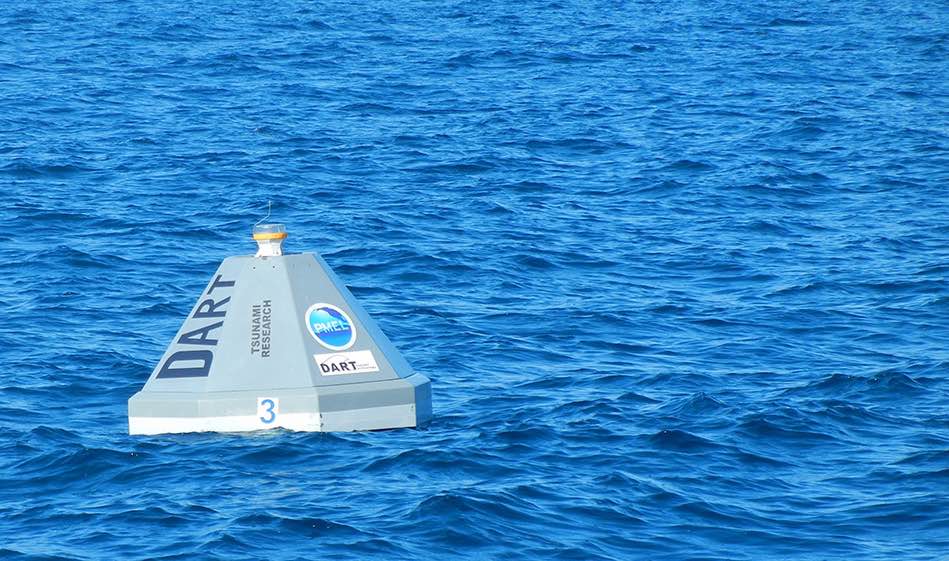 Source: NOAA
Source: NOAA
- Satellite imagery. Satellite technology plays a crucial role in monitoring and detecting tsunamis. Satellite-based sensors can detect changes in sea surface topography, temperature, and color that may indicate a tsunami.
- Global navigation satellite systems (GNSS). GNSS, such as GPS (Global Positioning System), measures ground movements and deformations associated with seismic activity.
These technologies and methods work together to detect and monitor tsunamis, providing critical information for tsunami warning centers and authorities. As a result, they can take appropriate actions to mitigate the tsunami aftermath.
